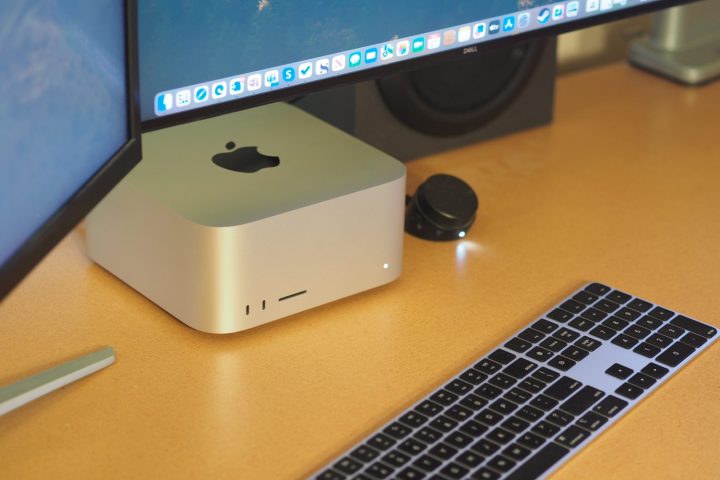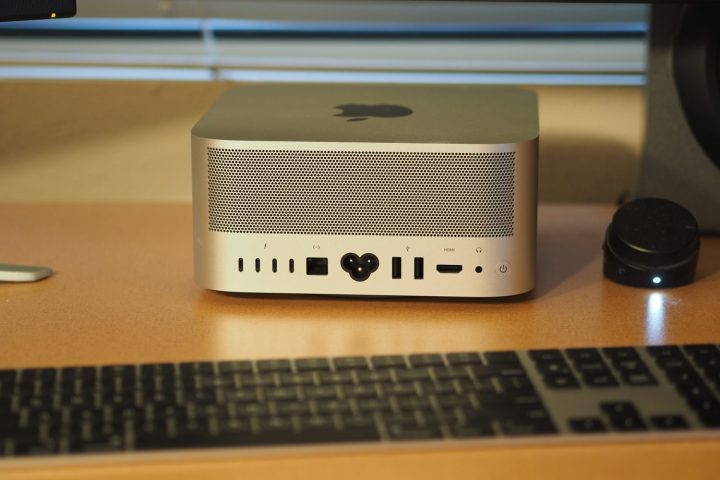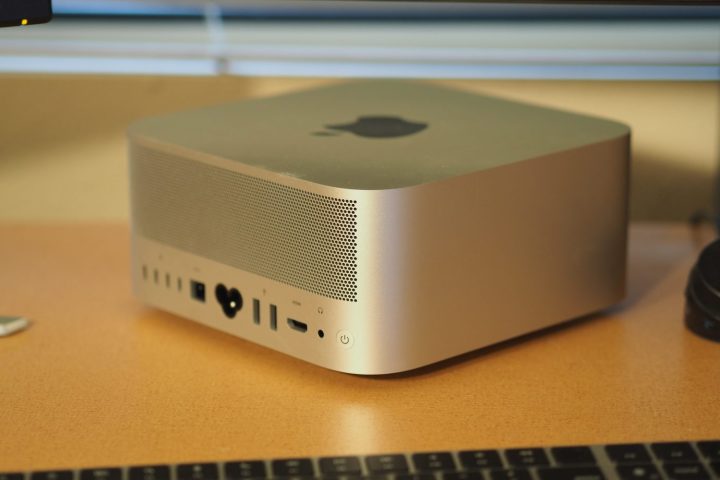While Windows desktops offer fantastic alternatives to the Mac mini and Mac Pro, the Mac Studio continues to sit in its own unique sphere. Part compact PC and part powerhouse, it’s the kind of device that’s only possible thanks to the massive success of Apple Silicon.
When it comes down to it, that means nothing on the Windows side of the aisle can duplicate the kind of efficiency and performance the Mac Studio offers. I have a strong feeling that even with the Mac Studio currently being stuck on the M2 generation, that will remain true for a long time.
Specs and configurations
| Dimensions (HxWxD) | 3.7 x 7.7 x 7.7 inches |
| CPU/GPU | M2 Max 12-core CPU/30-core GPU M2 Max 12-core CPU/38-core GPU M2 Ultra 24-core CPU/60-core GPU M2 Ultra 24-core CPU/76-core GPU |
| Case | Apple CNC aluminum |
| Memory | 32GB unified (M2 Max) 64GB unified 96GB unified (M2 Max 38-core GPU) 128GB unified (M2 Ultra) 192GB unified (M2 Ultra) |
| Storage | 512GB SSD (M2 Max) 1TB SSD 2TB SSD 4TB SSD 8TB SSD |
| Power supply | Apple 370W |
| USB ports | 4 x USB-C with Thunderbolt 4 on rear 2 x USB-C on front (M2 Max) 2 x USB-C with Thunderbolt 4 on front (M2 Ultra) 2 x USB-A on back 1 x HDMI 1 x 10GB Ethernet 3.5mm audio jack on back SD card reader on front |
| Wireless | Wi-Fi 6E, Bluetooth 5.3 |
| Price | $1,999-plus |
The Mac Studio is an expensive machine, starting at $1,999 with a previous-gen M2 Max CPU, 32GB of RAM, and a 512GB SSD. Configure it with an M2 Ultra, 192GB of RAM, and an 8TB SSD and it costs a stratospheric $8,799.
Depending on their configuration, Windows desktops can cost under $500 and over $10,000. Thousands of combinations of components are available, making the Windows desktop a much more flexible machine.
Built on price alone, you could certainly build your own PC for $1,999 that far surpasses the Mac Studio in terms of performance. But as we all know, the Mac Studio was really never meant to compare on that level.
A solid hunk of simplicity

The Mac Studio is an incredibly well-built machine, made of CNC-machined aluminum and coming in a single silver color. It’s a minimalist design that retains Apple’s usual elegance and creates the illusion of floating on air from the usual desktop angle.
Undoubtedly, the Mac Studio is meant to sit on top of a desk. It’s very small, taking up just under 8 inches on each side and under 4 inches from top to bottom, so most people will be able to find some space for it on their desktops.
As mentioned above, Windows desktops come in all sorts of variations. There are mini-PCs that rival the Mac Studio in size, although I’m not aware of any that are as cohesively designed. One mini-PC in the same general class is the HP Z2 Mini G9 Workstation, which is 8.3 inches deep and 8.6 inches tall while being 2.7 inches thick. One significant difference is that the HP is somewhat upgradeable, which means it doesn’t have the Mac Studio’s unibody design. Aesthetics are subjective, but one could argue that the Mac Studio is the more elegant machine.

Most Windows desktops come in various tower sizes, usually meant to sit on the floor. Aesthetics are also all over the place, with some very clean and some outlandish designs. You’ll also find various lighting solutions for Windows desktops, including RGB lighting that can change to meet system conditions and gaming environments.
You’ll be hard-pressed to find a Windows desktop that can match the Mac Studio’s attention to detail, but you’ll also be able to personalize a Windows desktop that more closely matches your personality. Unless, of course, your personality matches Apple’s fastidious design, in which case the Mac Studio will be perfect for you.
Good connectivity but no expandability

You’ll be hard-pressed to find a Windows desktop with as many as six Thunderbolt 4 ports, but that’s what you’ll find in the Mac Studio M2 Ultra edition (four on the back and two on the front). The M2 Max version has four Thunderbolt 4 ports and two USB-C ports on the front. Then, you’ll get two USB-A ports, a 10GB Ethernet connection, an HDMI port, a 3.5mm audio jack, and an SD card reader.
Windows desktops will likely have more USB-A ports, while the GPU, whether integrated or discrete, will offer more HDMI and/or DisplayPort connections.
Where most Windows desktops win out is in expandability. You’ll certainly be able to increase the RAM and storage and add more storage devices than just the single SSD in the Mac Studio. Depending on the motherboard, you may be able to upgrade the CPU, and most Windows desktops will let you swap out the GPU — or even add a second GPU for additional performance.
The Mac Studio, on the other hand, has zero expandability. That’s right, there’s not a single component that can be upgraded. The typical Windows desktop is infinitely more expandable.
Good to great performance, but not the greatest

The Mac Studio uses Apple’s M2 Max and M2 Ultra chipsets. These fast and efficient CPU and GPU combinations are particularly suited for creative work. Windows desktops can be equipped with much faster CPUs and GPUs and, ultimately, can be a lot faster.
To get a taste of the performance difference, consider the table below. We haven’t tested the Mac Studio with the M2 Max, so the MacBook Pro 14 will be used as a proxy. The Mac Studio is likely to be faster, given better thermals. We also haven’t tested the fastest version of the M2 Ultra with 76 GPU cores, so I’m posting the next fastest results here.
I’ve selected a couple of Windows desktops for comparison purposes, including a custom-built PC with some very fast components. That customizability is, of course, one of the advantages of the Windows platform.
Gaming is the one exception in the Mac Studio’s commanding lead.
As you can see, the Apple chipsets are competitive with the custom Windows PC running a 24-core (eight Performance and 16 Efficient), 32-thread Core i9-13900F in the single-core portion of the Cinebench 2024 benchmark, and they’re faster than the 16-core (eight Performance and eight Efficient), 24-thread Core i7-13700F. The M2 Max and M2 Ultra fall behind the Core i9 in the multi-core portion of the benchmark, while the M2 Ultra is faster than the Core i7. Neither Apple GPU can keep up with either Nvidia GPU in the GPU test.
Interestingly, the Mac Studio with the M2 Ultra is 15% slower than the custom PC in the Pugetbench Premiere Pro benchmark that runs in a live version of Adobe’s Premiere Pro, but it’s 18% faster than the Alienware Aurora R16 with an RTX 4070. The Pugetbench benchmark tests the GPU’s performance in addition to the CPU, and Apple has clearly optimized its architecture to do well in creative applications. That means that you’ll need to outfit a very powerful Windows desktop to get better productivity performance than the Mac Studio with the M2 Ultra.
I won’t spend much time discussing gaming because the Mac Studio is no match for Windows desktops. Windows GPUs can achieve much higher framerates in modern titles, and Windows has far more games available than MacOS. If you want a gaming PC, you’ll want a Windows desktop.
| Cinebench R24 single-core |
Cinebench R24 multi-core |
Cinebench R24 GPU |
Handbrake (in seconds) |
Pugetbench for Premiere Pro | |
| Mac Studio (M2 Ultra 24/60) |
120 | 1,870 | 7,727 | 56 | 978 |
| MacBook Pro 14 (M2 Max 12/38) |
121 | 1032 | 5592 | 85 | N/A |
| Custom Windows PC (Core i9-13900K/RTX 4090) |
126 | 2083 | 34,230 | N/A | 1,148 |
| Alienware Aurora R16 (Core i7-13700F/RTX 4070) |
112 | 1,070 | 16,974 | N/A | 828 |
Oh, but that sweet silence

If you use a powerful Windows desktop, you’re likely familiar with the roar that inevitably emanates from the case whenever you fire up an intensive application or start running a demanding game. Some Windows desktop configurations are quieter than others, but you’ll have to choose slower components to get one that’s reasonably quiet. In fact, you’ll find that Windows desktop component reviews, particularly for GPUs, often include sections on decibel levels. That’s true of both Windows tower desktops with tons of room for airflow and smaller machines like the HP Z2 Mini G9.
You’ll find no such information available for the Mac Studio. That’s because it’s completely silent in normal operation and emits a barely audible hum when working hard. Apple created a fantastic thermal solution that moves a ton of air without making much noise, and the M2 chips are highly efficient and so put out less heat than Intel, AMD, and Nvidia equivalents. It’s just easier to keep Apple’s chips cooler without requiring noisy fans.
I have a Mac Studio sitting on my desk just a few feet away from my ears, and I’ve yet to notice any noise. That’s amazing compared to my Windows desktop, which sometimes sounds like a jet fighter taking off.
Simplicity vs. complexity
If you want a desktop PC that you can expand as your needs grow, then the Mac Studio isn’t for you. If you configure it poorly, you’ll have to sell it and buy a new machine to upgrade its performance. That’s not true with Windows desktops, which are eminently expandable.
On the other hand, no Windows desktop looks as good as the Mac Studio, and you’ll be hard-pressed to find one that’s so quiet. The Mac Studio is plenty fast for even the most demanding users, as long as gaming isn’t important, and it can be equipped with insane amounts of RAM and storage. For most people, and especially for macOS fans, the Mac Studio is a superior choice with no equal.
Editors' Recommendations
- Mac desktops need a serious boost
- Why I went with the MacBook Pro over the Mac Studio
- The easy way to choose between the Mac Studio and Mac mini
- Apple’s serious miscalculation with the 15-inch MacBook Air
- Why the latest ThinkPad X1 Yoga Gen 8 isn’t worth the upgrade


